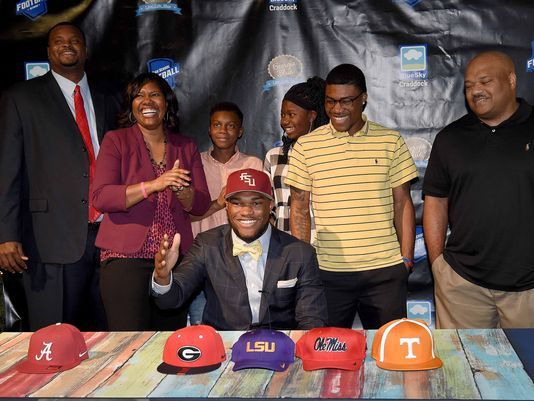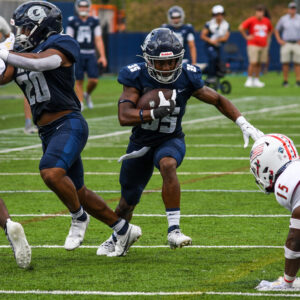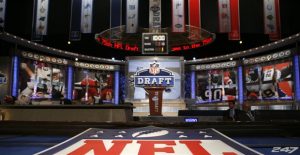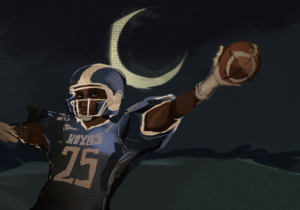Signing top recruits remains the most predictive factor of a college football program’s success, and five-star recruits are the surest tickets on the market. So how do you convince one of these top talents to sign for your program? Depending on the different attributes of your university, it’s necessary to leverage a school’s academic opportunities, proximity to a recruit’s home, and championship aspirations to different extents. More than anything, though, recruits ask the same question any other student does: which of these universities is the most likely to turn me into a handsomely-paid employee after college?
Now, of course, most recruits envision themselves as players in the National Football League and have been told as much their entire adolescence. Heck, there are 32 five-star recruits in each high school class to represent the 32 first-round picks in the NFL Draft.
The easiest way to convince a recruit that you’re the right person to get them to the pros is to show them you’ve done it before. We know the teams that have placed the most players in the NFL Draft in recent years are the teams that do a lot of winning. The logic is simple: if a player is good enough to star (or simply start) on one of the best teams in the country, they’ll probably become a solid professional as well.
However, we can dive much deeper. Five-stars, for all their excellence at the high school level, are no sure bet to make it to the NFL. Due to NFL teams’ preference to prioritize certain valuable positions on the field early in the draft, I’ll extend the window to deem a five-star recruit’s college career a developmental success to getting drafted within the first 50 picks of the NFL Draft. Using the last ten years of 247Sports’ recruiting data based on respective professional timelines (recruiting classes from 2007-16), only 86 of the 320 five-star recruits (26.9%) went on to become top-50 picks in the NFL Draft. In fact, only a shade over half of them (57.2%) were even drafted within the 230-some selections.
Let’s think about that for a second. Imagine if the 32 most gifted high school seniors earmarked for careers in investment banking in the country were tracked during college (and imagine if they only wanted a career in investment banking). Maybe you disagree, but to me it seems pretty likely that they’d wind up securing some unbelievable jobs in IB. But only 27% of elite high school football players are still as highly regarded coming out of college, and 43% of them don’t even get a hard offer to play football in the NFL. There are lots of tremendous banking jobs across the world. But there are a very limited number of million-dollar gigs in football.
So there’s a lot riding on a five-star recruit’s decision, and they know it. Alabama, as we’ll see, secured the most five star recruits from 2007-16 and placed a stunning amount of them as high draft picks. It would make a lot of sense to sign for the Tide, especially considering their recent on-field success. But what if there’s another elite recruit at your position also set on heading to Alabama, and two more in the class above you? Now there’s a chance you don’t even get on the field much to be evaluated by scouts. Conversely, at a smaller school that’s going to offer a clear opportunity to play early and often, you might not make it to the NFL for a variety of reasons: higher injury risk from excessive usage, coaching instability, less national exposure. The list goes on.
This considered, let’s look at which schools have been able to turn five-stars into successful draft prospects, and which schools haven’t. Further, how have those results looked different recently due to program changes? I’ll also single out some schools that have been excellent (or really poor) at developing talent at a certain position, all in hopes that we can recognize why five-stars are interested in the schools they’re interested in.

Above are the schools that signed the most five-stars in the most recent set of ten aged-out recruiting classes. These are the so-called “high volume” schools because they signed ten-plus five-stars across the ten recruiting classes for an average of at least one five-star per cycle.
The results of this simple chart are more surprising than my account of which schools had signed the most Top 300 recruits across six recruiting classes in the last decade as part of a recent article. As you might’ve guessed, there’s going to be a bigger disparity between the top-dog schools here, Alabama and USC, and the rest of the high volume schools. That’s because everybody is targeting five-star recruits hard, where guys that are “only” Top 300 recruits might not have the Bamas and USCs of the world going all-in on them. But for the five-stars, it’s difficult to turn down the most prestigious programs when they’re really going after you. Seeing names like USC and Florida State near the top of this list while Clemson was at the bottom and Oklahoma didn’t even chart, though, was interesting and a reminder of how the college football landscape has changed in the past decade.

Now we get into the meat of the exercise. None of these schools were head-and-shoulders above the pack in turning their five-stars into draft picks, though Alabama’s rate is impressive considering the volume of five-stars they’ve recruited. Where the Crimson Tide really separate themselves, though, is in their absurd ability to place their elite recruits near the top of NFL drafts. Nick Saban’s program put 20 of their 35 five-stars (57.1%) among the top 50 picks, a rate more than double the overall Top 50 rate. Florida State and Notre Dame were also among the best performers by this metric, but nobody comes close to matching the Tide’s ability to recruit five-stars in bulk and still find a way to position so many of them as elite draft prospects three or four years down the road.
At the bottom of the chart, Texas had a startling bust rate among its five-stars. The Longhorns will always be able to recruit at a high level due to their name-brand status on some incredibly fertile recruiting turf, but there’s a reason five-star recruits from the Lone Star State have been signing for out-of-state schools more often in recent years. Meanwhile, Ohio State and Georgia are tremendous programs with disappointing Top 50 placement rates, but with Ryan Day and Kirby Smart now at the helm of each school, respectively, that’s more an indictment of previous coaching staffs than a statistic likely to have predictive value into the future.
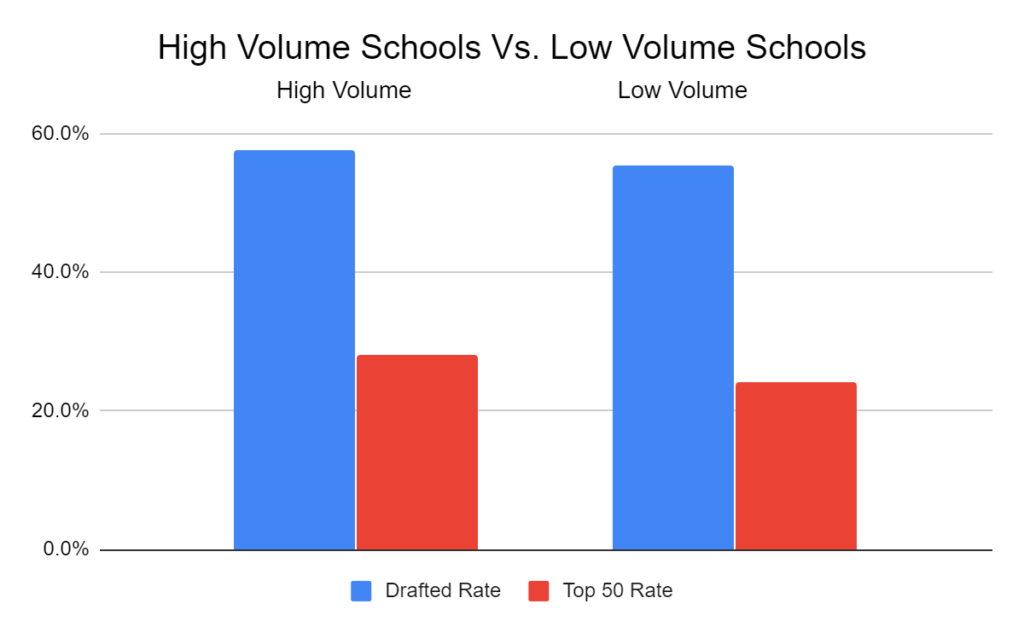
Meanwhile, there is almost no difference in the rates at which high-volume and low-volume programs (less than ten five-stars signed across the ten classes) place five-stars in the NFL Draft or within the top 50 picks. So one can’t unilaterally say a five-star needs to go to a school that has dealt with five-star recruits before to maximize their NFL chances – there are pros and cons at play for each type of program.
Among notable cases, Miami didn’t place a single one of their nine five-stars from 2007-16 in the Top 50 in the draft – the Hurricanes’ standing nationally has taken a hit in every respect over the last decade. Additionally, only two of Oklahoma’s nine five-stars were drafted at all. Combined with Texas’ disappointing draft rate, it seems NFL scouts really held the Big 12’s “anti-defense” reputation in the 2010s against prospects coming out of the conference.
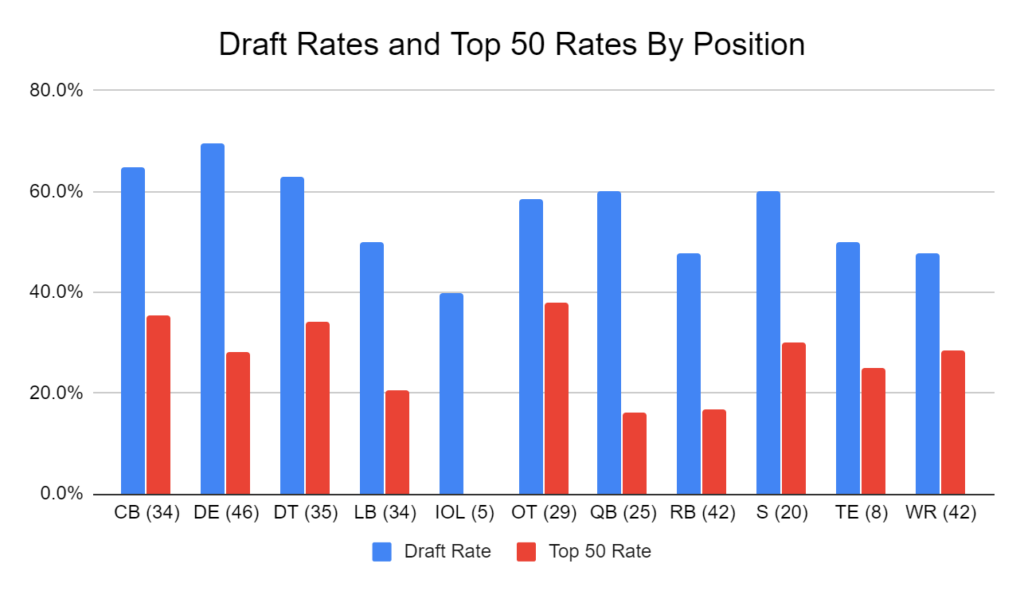
Above are the drafted and Top 50 pick rates by position among the five-stars in the data set. As an aside, there don’t appear to be any positions at which high school recruits are much easier to confidently project. Running back, linebacker, and wide receivers were the positions that proved particularly difficult to project, perhaps because those positions are highly instinctual, a trait which must be extremely tough to evaluate among high schoolers.
Some quick hitters:
- Will the real DBU stand up? Alabama landed a whopping ten five-star recruits in the secondary and put six of them in the top 50 of the draft, while Florida State saw four of their eight five-star DBs go that early. Talent development goes much deeper than only working with five-stars, of course.
- The only position at which Nick Saban hasn’t been able to recruit and develop his five-stars? That would be quarterback, as both Phillip Sims and Blake Barnett left Alabama early in their college careers before later going undrafted. The Tide should be just fine with 2020 No. 1 overall recruit Bryce Young, though.
- Ten of Ohio State’s fourteen five-stars played defense. Just one was drafted in the Top 50 picks out of OSU (Nick Bosa). This year, funnily enough, two Buckeyes defenders, Chase Young and Jeff Okudah, were selected second and third overall in the NFL Draft.
- The recruiting battles in the trenches in the state of Mississippi (of all places) were really something. Ole Miss only landed two five-star offensive linemen from 2007-16, and Mississippi State only signed two five-star defensive linemen, but when the Rebels landed Laremy Tunsil and Greg Little at offensive tackle, the Bulldogs responded by signing Chris Jones and Jeffery Simmons across from them. All four players are either already elite or extremely promising NFL players.
- Can you name the only two Group of Five schools to sign a five-star from 2007-16? That honor would go to Southern Miss and Houston. USM shockingly inked in-state stud wideout De’Andre Brown back in 2008 – after a dominant freshman season, De’Andre’s numbers went down in each of the next two years, and he went undrafted. Meanwhile, Houston signed local star Ed Oliver in 2016 in one of the headline recruiting stories of the past decade. Oliver was dominant from day one, won the Outland Trophy as the nation’s best lineman as a sophomore, and is well on his way to a productive NFL career with the Buffalo Bills, who took him ninth in the 2019 draft.
Whether we’re discussing football players or future doctors, the best of the best want to go to universities that will position them well after undergrad. Some schools’ results are simply unmatched (Alabama), some schools haven’t been able to follow through for recruits (USC, Texas), and still others have proven able to do more with less (Clemson). Next time you’re scratching your head when a local five-star recruit is leaning toward signing for your favorite team’s archrival, though, remember that these players are likely placing their assessment of different programs’ abilities to get them to the NFL above almost anything else.


